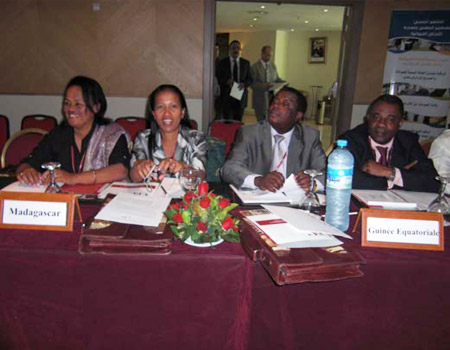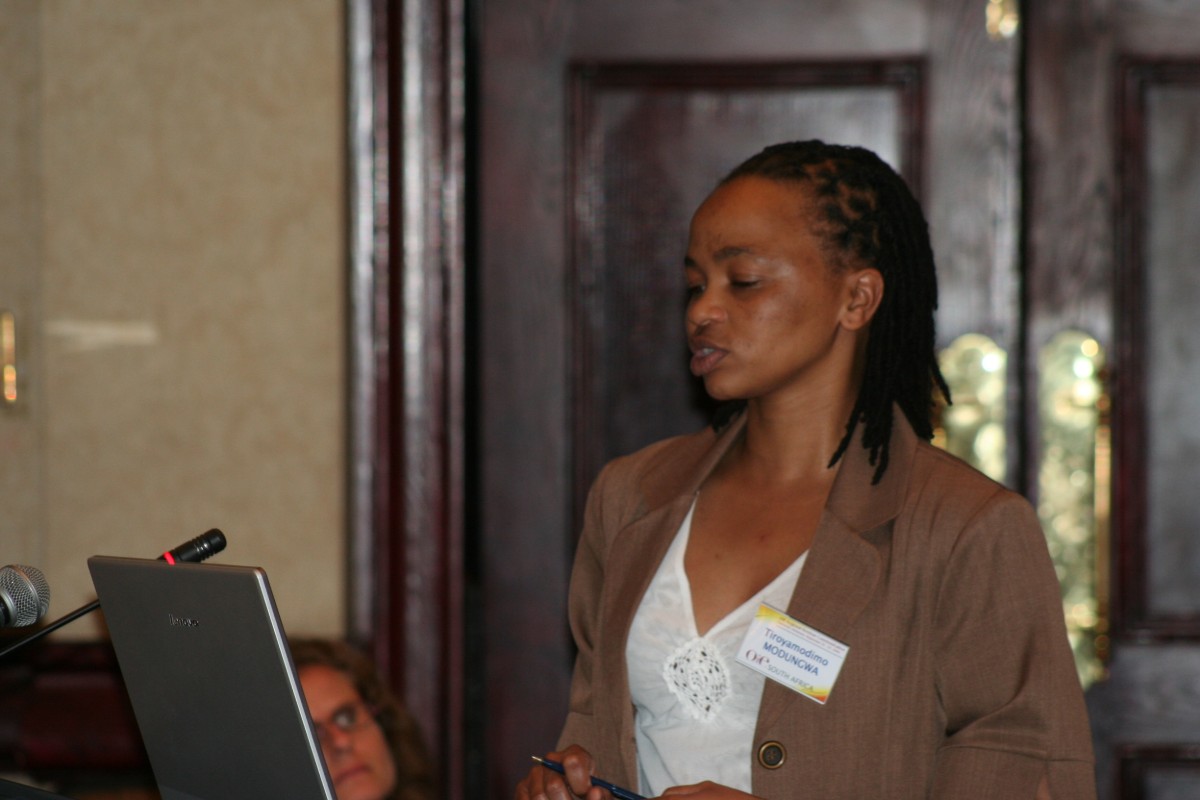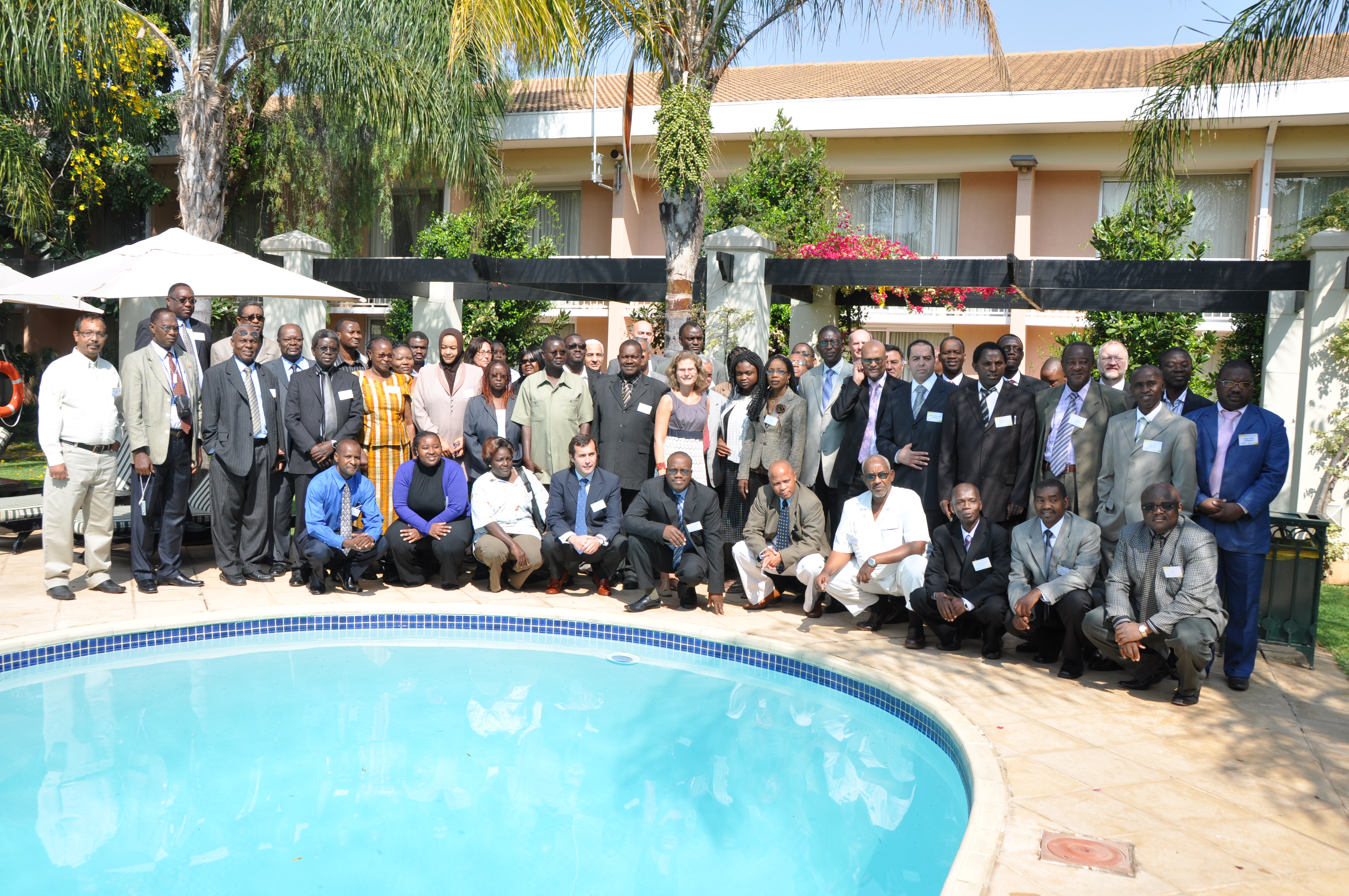
Representatives of veterinary services and the communication units therein (where they exist) from English speaking African countries met with communication and press professionals in the region to discuss how to better package and disseminate animal health information through the various communication and information channels that exist today, from the written press, over television to blogs and sms.
Dr Tiro Modungwa, DAFF (South Africa). Picture (c) P. Bastiaensen (oie) 2009
The seminar, which took place in Gaborone, Botswana on September 22nd and 23rd, included the participation of public (official) veterinary services, private sector representatives (e.g. the Southern African Poultry Association) and the consumers (Consumers International), and was attended by some 65 delegates from 21 OIE member countries, as well as representatives from the OIE regional offices in Gaborone, Botswana; Tunis, Tunisia and the OIE headquarters in Paris, France. The communication professionals came from both government communication offices and the private sector, such as e.g. Agence France Presse (AFP) and The East African (Nation Media Group Kenya).
Case studies were presented from various regions of Africa, from Ghana to Nigeria, from Egypt to Somalia, from Kenya to Botswana and from Angola to Namibia. The meeting, through its debates, demonstrated the mistrust that sometimes reigns between the two professions and the need for strengthening of communication units within the veterinary services, along with the development of regional communication strategies
Picture (c) P. Bastiaensen (oie) 2009
(endorsed by the OIE Director-General)
Considering :
– That the OIE international Committee voted in May 2001 Resolution n° XXI on the “role of communication management in assisting Veterinary Services”,
– That this Resolution recommends on its article 7 that the OIE provide support to Members,
– That this resolution refers to communication, beyond extension or education activities,
– The outcomes of several OIE PVS evaluations so far conducted in the Africa region,
– That the worldwide focus on animal health issues leads to an increased demand for accurate and scientifically-based opinion and information on animal diseases, including zoonoses,
– The responsibility of national Veterinary Services to help ensure animal disease control, food safety, food security, thus contributing to poverty alleviation,
– That the regulation for the control of animal diseases and zoonoses in international trade of animals and animal products calls for accountability of national veterinary services and competent authorities, towards the general public and other stakeholders,
– That permanent, accurate and timely communication between animal health authorities and public health authorities is a key factor for preventing and controlling zoonoses, such as promoted by the OWOH
concept,
– That the transparency and quality of communication and information management, in particular in crisis situations are issues of national, sub-regional, regional and global strategic significance,
– The multiplicity of communication projects and initiatives carried out by relevant organisations within the region,
– That the development of information and communication strategies contributes to improving the functioning and the acceptance of the scientific, technical and operational output of Veterinary Services,
– The major role of media in disseminating information as well as in raising public awareness,
– That Members and the OIE must have access to adequate human, technical and financial resources in order to manage information and communication at the national, regional, sub regional and global level and methodological training in this field is indispensable,
Participants of the seminar recommend that :
1. An improved global, regional, sub-regional and national veterinary governance must encompass communication policies, strategies and resources directed to the stakeholders and the general public;
2. The importance of the process of communication must be among the priorities of OIE Regional and Sub Regional Representations, RAHCs and national Veterinary Services, particularly for disseminating information;
3. The OIE continue to provide technical support to all Members particularly developing countries to strengthen the communication capacities in the Veterinary Services in order to continuously respond to national and international demands and to help Members to comply with OIE standards, guidelines and recommendations;
4. Members should assess their needs taking into account the relevant criteria of the OIE PVS Tool to develop information and communication strategies within Veterinary Services to respond to both crisis situations and routine/long term requirements;
5. Communication teams, including professional communicators, should be fully integrated as a component of the Veterinary Services and under the direct authority of the Veterinary Authorities;
6. Chief Veterinary Officers should request Government authorities to provide adequate organisational and budgetary support for the communication objectives of Veterinary Services, including communication training, in accordance with Resolution XXI of May 2001 voted by all OIE Members;
7. National Veterinary Services communication teams liaise closely and on a regular basis with OIE and other relevant international organisations, on specific events requiring coordination in information, dissemination and/or communication management;
8. National Veterinary Services communication teams liaise with their counterparts within the public health services for the coordination in information, dissemination and/or communication strategy and management on the prevention and control of zoonoses;
9. National Veterinary Services must communicate with other relevant stakeholders (private sector, producers, consumers);
10. Members identify and communicate to the OIE the data of the communication officer within the communication team of their national Veterinary Services, the team and the officer being nominated by and under the general direction of the Chief Veterinary Officer;
11. The OIE provide Members with the guidelines of communication and information strategies within its field of competence, and assist Members in developing strategies n collaboration with the RAHC and Regional Economic Communities through existing alliances and coordination mechanisms such as the GF-Tads;
12. Media training sessions on relevant animal health issues are being organised on a regular basis by the national Veterinary Services, with the possible assistance of the OIE Regional and/or Sub-Regional office;
13. OIE Members are urged to proactively make transparent and science based information available to the media and the general public, thereby strengthening Veterinary Service’s public image as an accountable and authoritative source of information on any relevant event relating to animal health and public health;
14. The OIE be considered by its Members as the lead organisation for development of international strategies on the communication of standards, guidelines and recommendations on animal health and welfare and the relevant OIE press releases and editorials, as well as any OIE communication support, be taken as an appropriate basis for the communication of national Veterinary Services.
All pictures (c) P. Bastiaensen and J. Daamen (oie) 2009



